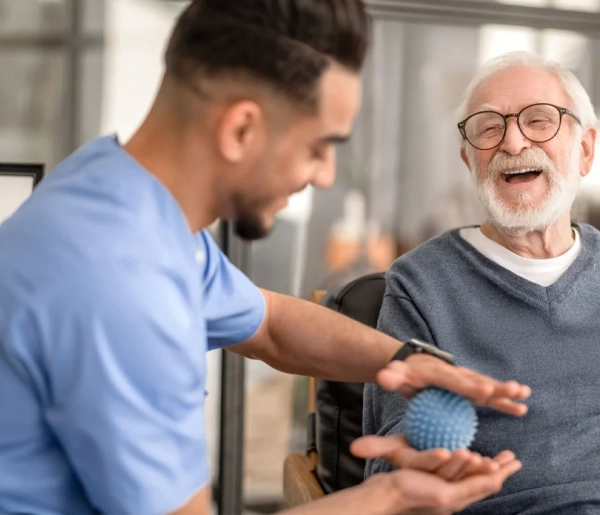Physical therapy (PT), commonly referred to as physiotherapy, is a vital branch of physical medicine focused on helping patients recover from physical trauma.
Physiotherapy aims to strengthen compromised areas of the body and assist individuals in regaining their ability to function normally in daily life. Professionals in this field, known as physiotherapists, work with patients either in their homes or at dedicated physiotherapy centers.
Utilizing a range of tools and techniques, physiotherapists help patients achieve maximum physical ability, primarily focusing on everyday movements such as walking, eating, and bathing.
By improving mobility and function, physiotherapy plays a crucial role in the rehabilitation process for those recovering from injuries or surgeries.


Cambridge Medical & Rehabilitation Center is a leading provider of physiotherapy services in the United Arab Emirates and Saudi Arabia. Our state-of-the-art facilities are dedicated to enhancing the quality of life for our patients through tailored rehabilitation programs.
We offer comprehensive physiotherapy services for adults, adolescents, and children, ensuring personalized care that supports the entire recovery process.
Our goal is to create customized physiotherapy plans that not only focus on rehabilitation but also engage family members in the treatment journey.
These services are an integral part of the holistic care offered at CMRC. We ensure a seamless transition from inpatient rehabilitation to outpatient physiotherapy, which is crucial for successful recovery.
By providing ongoing assessments and multidisciplinary support, we help patients reintegrate into their communities safely and effectively.
Our physiotherapy services include regular follow-ups, care coordination, and community reintegration support, ensuring that patients receive effective care throughout their recovery journey.
Experience an environment that feels like #YourSecondHome.
What is CMRC Physiotherapy Services?
CMRC Physiotherapy Services is a specialized provider of physiotherapy and rehabilitation services aimed at helping patients recover from physical injuries, surgeries, and other health conditions affecting mobility and function. It typically offers a range of treatments including manual therapy, exercise programs, hydrotherapy, and specialized care for various conditions such as sports injuries, postoperative recovery, stroke rehabilitation, and more.
Why is CMRC Physiotherapy important?
CMRC Physiotherapy is important because it plays a crucial role in the recovery and rehabilitation process for individuals who have experienced physical trauma or loss of mobility. By employing trained physiotherapists, CMRC Physiotherapy helps patients regain strength, flexibility, coordination, and overall functionality.
This not only aids in physical recovery but also enhances quality of life, promotes independence, and can prevent future injuries through education and proper exercise techniques. Additionally, physiotherapy can address chronic pain management and improve overall wellbeing.
Physiotherapy can provide care for people who have lost the ability to move owing to the following examples, and more:
Physical Therapy can help patients regain the following plus It is also a solution for chronic pain relief and can help improve posture:
- Coordination
- Endurance
- Flexibility
- Balance
- Strength
Tools Employed by Physiotherapist
The physiotherapist uses a wide range of tools to help their patients, including:
- Exercise balls: This tool helps patients find their neutral spine position, improve posture, increase lumbar mobility, and work on balance and stability.
- Swimming pools: Also known as hydrotherapy, some physiotherapists will use swimming pools to help their patients regain muscle mass and improve their movement. It is practiced in warm water, which helps improve blood circulation and relax tensed muscles. Hydrotherapy is excellent for those who need help with arthritis, have spinal cord injuries, or need to regain their complete movement ability after a stroke.
- Hot and cold packs: These can either help with vasodilation or vasoconstriction of blood vessels) and hence control blood circulation. Hot packs can also help sore muscles relax.
- Electrical muscle stimulation (EMS): EMS is concerned with stimulating muscles with the help of electrical impulses, which encourage muscle contraction. It can help with joint pain, muscle development, improve blood flow, and increase the range of motion for tensed up muscles and tendons.
Other tools are also used in physiotherapy treatment, particularly orthopedic equipment like braces, casts, and splints. These help with bone structure development and overall posture. These tools help improve the patient’s quality of life and give them a better shot at complete recovery.
Once recovery is complete, the patients will be discharged from the hospital and enjoy a high-quality lifestyle despite having once faced problems with movement.
Hydrotherapy
Hydrotherapy, or aquatic therapy, is a branch of physiotherapy that uses water as its primary tool. Swimming pools are the main form of equipment, and warm water is used more often than cold. Hydrotherapy helps with the following:
- Flexibility
- Relaxation
- Overall movement
- Gait and locomotion assistance
- Coordination
- Limb strength
- Stress reduction
- Enhancement of aerobic capacity
Unlike general aquatic sport, hydrotherapy is a medical tool and is hence covered by most insurance providers. Only a trained expert can administer hydrotherapy. Here are the general benefits of hydrotherapy:
- The warm water used in hydrotherapy opens up and loosens the muscles, hence reducing muscle soreness. This improves flexibility and movement. It also promotes vasodilation, which is key to healthy blood circulation; in turn, the blood circulation boosts the rate of recovery by supplying the body with nutrients, oxygen, and more.
- The buoyancy and hydrostatic pressure offered by water let aching joints and muscles rest while still allowing the body to move and exercise, but without harming the already-damaged joints and muscles.
- Respiration is also improved; the lungs and circulatory system are expected to work harder to support movement in the water. As a result, blood flow is improved, and oxygen-rich blood is supplied to the body. Oxygen debt and lactic acid residue are successfully overcome, and, in turn, the patient’s muscle cramps go away.
- Water has viscosity, which makes movement easier in some ways, but harder in other ways. This viscosity is the reason why some experts recommend hydrotherapy to patients who need to strengthen their muscles without pressuring their joints.
As you can see, there are numerous benefits associated with this method. Hydrotherapy can offer things that on-land exercises cannot, which is why it is a major part of physiotherapy and is recommended to almost all patients.
Sports Rehabilitation
Sports injuries are quite common in today’s world; they can happen to anyone, be it a professional athlete or an amateur player. Sports medicine, including physiotherapy, is important for those suffering from chronic pain, a significant injury caused through sports and athletics, or an illness concerning their musculoskeletal system.
Common sports injuries include:
- Ankle sprains
- Groin pull
- Hamstring damage
- Knee injury
- Tennis elbow (epicondylitis)
- Shin splints
- Carpal tunnel syndrome
- Back pain caused by disc problems
- Stress fracture
Each of these has a unique mode of treatment, but all of them do require the help of a trained physiotherapist. There are special physical therapists for such purposes called sports rehabilitators. They are trained to cater to primarily those experiencing sports injuries rather than others, like patients with cerebral palsy.
Sports rehabilitators are trained to deal with two types of sports injuries:
Macro-traumatic injuries:
These are generally characterized by a tissue injury and caused by a strong force caused by a sudden impact, like a collision caused by a push or fall. They are most commonly noted in sports like football, otherwise known as contact sports.
Micro-traumatic (Overuse) injuries:
Such injuries are a result of repeated and excessive use of the same joint, muscle, or tendon. They are commonly seen in sports like rowing, cycling, and swimming.
Physiotherapy should begin as soon as possible after the injury is detected. A professional can help ensure that the body heals the right way and that the patient doesn’t leave the hospital with a compromised body.
Physically active individuals should remain conscious of their body and try not to exert themselves; this is easier said than done but should be kept in mind at all times. The body is not a machine, and pushing it too far can cause damage. While most traumas can be healed using physiotherapy, it is still far better to be safe than sorry.
Postoperative Care
Some people will need physiotherapy after a surgical procedure. This is called postoperative care and is recommended to a surgical patient who has gone through an operation that could cause potential complications involving their bones, muscles, tendons, joints, and ligaments.
A hip replacement patient, for example, will need physiotherapy because they have experienced surgery concerning bone and related fibers. Postoperative physiotherapy has three stages and can successfully help a patient regain full control of their body.
Early recovery phase:
This phase starts right after the patient is discharged from the surgical ward. It helps with tissue healing, reducing swelling, regaining the ability to walk, and general pain relief.
Strength and range of motion phase:
This is the second phase and begins once the pain and swelling post-op have gone down. It focuses on improving your range of motion and body strength by introducing difficult strength exercises, balance-therapy, soft tissue treatment, and aggressive manual therapy.
Functional restoration phase:
This is the third and last stage; it takes place once the surgery has mostly healed, and the patient’s strength is back. This stage is also tailored to meet the needs of the patients. For example, a sportsman will need to regain more abilities than an elderly person who doesn’t need to move around much either way due to their old age. This phase will also use manual therapy to restore the patient’s full joint range of motion.
Stroke Rehabilitation
Patients who have suffered a stroke will be in desperate need of physiotherapy. Stroke patients will generally begin seeing a physiotherapist within 24 hours of first having their stroke.
Experts recommend that a stroke patient take part in physiotherapy-related activities for at least 45 minutes per day, five days a week. This should go on till they are fully recovered.
Stroke patients can lose the ability to move; this may be a partial loss or a more severe condition. They will experience muscle weakness, which will impair their movement. After a stroke, the brain finds it harder to receive neural signals, or “inputs”; as a result, muscle movement is compromised, too.
Muscles that are not regularly exercised may shorten permanently as the body’s way of reacting to and coping with the stroke. As a result, muscle fiber length decreases, and limbs or other body parts may appear stunted.
Stroke patients also have reduced stamina, atrophied muscles, and other physical limitations. They can have trouble walking the way they used to or even performing mundane tasks like eating or bathing.
However, with the right therapy, all can go back to normal.
There are many benefits associated with stroke rehabilitation. Physiotherapy in stroke patients can help them regain full use of their bodies and prevent future strokes, too. The Physiotherapist employs a range of motion exercises to help stroke patients improve their physical condition.
They may also use advanced tools, like swimming pools, to help regain muscle strength. Circuit training, intensive repetition of regular everyday activities, and frequent stretching are all part of stroke rehabilitation physiotherapy.
Physiotherapy for Cerebral Palsy Patients
Cerebral palsy (CP) is a set of movement disorders that have been around since birth or early childhood. A person with cerebral palsy will experience the following symptoms:
- Poor coordination
- Stiff and weak muscles
- Tremors
- Compromised speech and hearing
- Vision problems
- Trouble swallowing
Physiotherapy is one of the main components in treatments concerning cerebral palsy. The degree of physical therapy needed by a patient depends on how extreme their condition is. Milder cases of the condition will require lesser physiotherapy than someone with more severe symptoms.
Physiotherapy is most effective when begun at a young age; the older the patient gets, the harder it becomes to treat them. In some cases, physiotherapy is enough to successfully treat a child with cerebral palsy. In other cases, physical therapy may need to be combined with other forms of treatment, like medication.
There are three types of cerebral palsy; each one needs a different type of physical therapy treatment:
Spastic Cerebral Palsy:
People with this kind of CP face muscle tension and jerky movements. Monitored and assisted stretching exercises are employed to provide relief to such patients.
Athetoid Cerebral Palsy:
Those with this form of CP need physiotherapy to help them toe their muscles, increase muscle mass, and become more in control of their overall movements.
Ataxic Cerebral Palsy:
Patients with ataxic CP have trouble with the balance due to compromised motor skills; physiotherapy can help with this by employing resistance and strength training exercises. Successful physiotherapy sessions can also help patients cope with pain from contractures, which is a condition caused by cerebral palsy spasticity.
Related Specialists
Frequently Asked Questions
Postoperative physiotherapy is crucial for recovery after surgery. It typically consists of three stages: early recovery, strength and range of motion, and functional restoration. This care helps reduce pain and swelling, regain mobility, and restore strength tailored to the patient’s needs, ensuring a smoother recovery process.
Physiotherapy plays a vital role in stroke rehabilitation. It helps stroke patients regain movement, strength, and coordination. Regular sessions focusing on range of motion exercises and functional activities can significantly improve their quality of life and reduce the risk of future strokes.
Cerebral palsy patients require tailored physiotherapy based on their specific type of CP. Treatments may involve assisted stretching for spastic CP, muscle control exercises for athetoid CP, and balance training for ataxic CP. Early intervention through physiotherapy can enhance mobility and overall quality of life for children with cerebral palsy.







